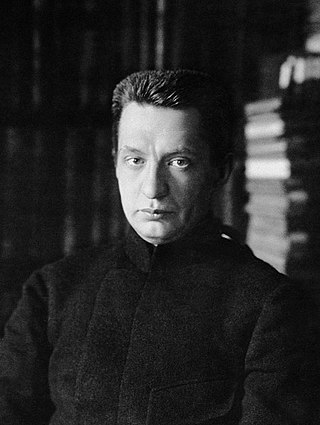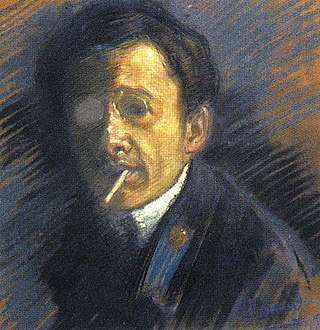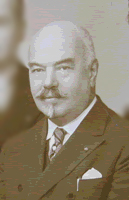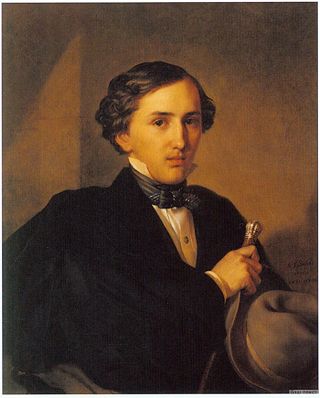
Alexander Fyodorovich Kerensky was a Russian lawyer and revolutionary who led the Russian Provisional Government and the short-lived Russian Republic for three months from late July to early November 1917 (N.S.)

Peter Carl Fabergé, also Karl Gustavovich Fabergé was a Russian jeweller best known for the famous Fabergé eggs made in the style of genuine Easter eggs, but using precious metals and gemstones rather than more mundane materials. He was one of the sons of the founder of the famous jewelry legacy House of Fabergé.

Ilya Yefimovich Repin was a Ukrainian-born Russian painter. He became one of the most renowned artists in Russia in the 19th century. His major works include Barge Haulers on the Volga (1873), Religious Procession in Kursk Province (1880–1883), Ivan the Terrible and His Son Ivan (1885); and Reply of the Zaporozhian Cossacks (1880–1891). He is also known for the revealing portraits he made of the leading Russian literary and artistic figures of his time, including Mikhail Glinka, Modest Mussorgsky, Pavel Tretyakov, and especially Leo Tolstoy, with whom he had a long friendship.

George Huntington Hartford headed the Great Atlantic and Pacific Tea Company (A&P) from 1878 to 1917. During this period, A&P created the concept of the chain grocery store and expanded into the country's largest retailer. He joined the firm as a clerk in 1861 and quickly assumed managerial responsibilities. When A&P's founder, George Gilman, retired in 1878, Hartford entered into a partnership agreement and ran the company until the founder's death in 1901. In the settlement of Gilman's estate, Hartford acquired control of the company and ultimately purchased the interests of Gilman's heirs.

Nathan Isaevich Altman Russian: Натан Исаевич Альтман, romanized: Natan Isayevich Altman; Ukrainian: Натан Ісайович Альтман; December 22 [O.S. December 10] 1889 – December 12, 1970) was a Russian avant-garde artist, Cubist painter, stage designer and book illustrator, who was born in Ukraine in the Russian Empire and worked in France and the Soviet Union.

Yury Pavlovich Annenkov ; 23 July [O.S. 11 July 1889] 1889 in Petropavlovsk, Akmolinsk Oblast, Russian Empire – 12 July 1974 in Paris, France), was a Russian artist mostly known for his book illustrations and portraits. He also worked in theatre and cinema (design). A member of Mir Iskusstva.

The House of Fabergé was a jewellery firm founded in 1842 in Saint Petersburg, Russia, by Gustav Faberge, using the accented name Fabergé. Gustav's sons – Peter Carl and Agathon – and grandsons followed him in running the business until it was nationalised by the Bolsheviks in 1918. The firm was famous for designing elaborate jewel-encrusted Fabergé eggs for the Russian Tsars, and for a range of other work of high quality and intricate detail. In 1924, Peter Carl's sons Alexander and Eugène Fabergé opened a firm called Fabergé & Cie in Paris, France, making similar jewellery items and adding the name of the city to their firm's stamp, styling it FABERGÉ, PARIS.

Nikolay Nikolayevich Kedrov Sr. was a Russian composer of liturgical music. His setting of Otche Nash is one of the best-known in the repertoire.

Fyodor Osipovich Schechtel was a Russian architect, graphic artist and stage designer, the most influential and prolific master of Russian Art Nouveau and late Russian Revival architecture.

Alexander Stepanovich Kaminsky was a Russian architect working in Moscow and suburbs. One of the most successful and prolific architects of the 1860s–1880s, Kaminsky was a faithful eclecticist, equally skilled in Russian Revival, Neo-Gothic and Renaissance Revival architecture. He is best remembered for the extant Tretyakovsky Proyezd shopping arcade and the cathedral of Nikolo-Ugresh monastery in present-day town of Dzerzhinsky.

Amandus Heinrich Adamson was an Estonian sculptor and painter.

TsUM — Central Universal Department Store is a high end department store in Moscow.

The Stroganov Palace is a Late Baroque palace at the intersection of the Moika River and Nevsky Prospect in St. Petersburg, Russia. The palace was built to Bartolomeo Rastrelli's designs for Baron Sergei Grigoriyevich Stroganov in 1753–1754. The interiors were remodeled by Andrei Voronikhin at the turn of the 19th century.

Georg Wilhelm Timm, also known as Vasily Fyodorovich Timm was a Baltic-German painter, lithographer and ceramic designer, known for his genre and battle scenes. He was also the publisher of the Russian Art Gazette.

Alexander Lvovich Parvus, born Israel Lazarevich Gelfand and sometimes called Helphand in the literature on the Russian Revolution, was a Marxist theoretician, publicist, and controversial activist in the Social Democratic Party of Germany.

Georgi Valentinovich Plekhanov was a Russian revolutionary, philosopher and Marxist theoretician. He was a founder of the social-democratic movement in Russia and was one of the first Russians to identify himself as "Marxist". Facing political persecution, Plekhanov emigrated to Switzerland in 1880, where he continued in his political activity attempting to overthrow the Tsarist regime in Russia. Plekhanov is known as the "father of Russian Marxism".
William Brandt's Sons & Co. Ltd was an Anglo-German merchant bank and accepting house in the early nineteenth and late twentieth century.
The Rusluie were a community of Dutch origin living in the city of Saint Petersburg in Russia, between 1720 and 1917. They originally came from the town of Vriezenveen, in the Dutch province of Overijssel.
Ventseslav (Vyatcheslav) Kuzmichev (Kousmichoff) was a entrepreneur and sailor from Russia, who represented his country at the 1912 Summer Olympics in Nynäshamn, Sweden in the 8 Metre. Creator of the brand Kusmi Tea.

Byloye was a monthly historical magazine published in the Russian Empire by Nikolay Elpidiforovich Paramonov and edited by Vasily Y. Bogucharsky (1861–1915), Pavel E. Shchegolev (1877–1931) and Vladimir L. Burtsev (1862–1942).

















